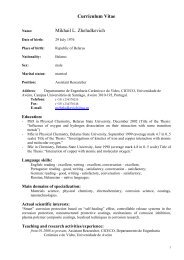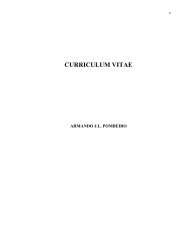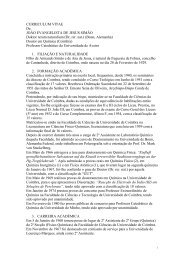XII Iberian Meeting of Electrochemistry XVI Meeting of the ...
XII Iberian Meeting of Electrochemistry XVI Meeting of the ...
XII Iberian Meeting of Electrochemistry XVI Meeting of the ...
You also want an ePaper? Increase the reach of your titles
YUMPU automatically turns print PDFs into web optimized ePapers that Google loves.
<strong>XII</strong> <strong>Iberian</strong> <strong>Meeting</strong> <strong>of</strong> <strong>Electrochemistry</strong> & <strong>XVI</strong> <strong>Meeting</strong> <strong>of</strong> <strong>the</strong> Portuguese Electrochemical Society K N 04<br />
Evaluation <strong>of</strong> antioxidant activity: a reagentless<br />
electrochemical approach<br />
Dulce Geraldo, Fátima Bento<br />
Departament <strong>of</strong> Chemistry, Universidade do Minho, 4710-057 Braga<br />
gdulce@quimica.uminho.pt<br />
The growing interest in <strong>the</strong> study <strong>of</strong> <strong>the</strong> action <strong>of</strong> antioxidants in health and<br />
biotechnology has led to <strong>the</strong> development <strong>of</strong> different analytical methods for <strong>the</strong><br />
evaluation <strong>of</strong> <strong>the</strong> antioxidant capacity <strong>of</strong> <strong>the</strong>se compounds.<br />
Cyclic voltammetry has been widely used in <strong>the</strong> analysis <strong>of</strong> samples containing mixtures<br />
<strong>of</strong> antioxidants. The analysis <strong>of</strong> voltammograms gives qualitative information, which<br />
relates to <strong>the</strong> identification <strong>of</strong> peaks, or waves resulting from overlapping voltammetric<br />
peaks. This information is usually used to evaluate <strong>the</strong> power <strong>of</strong> <strong>the</strong> antioxidants present<br />
in <strong>the</strong> sample. Quantitative information can be achieved by following two different<br />
approaches, consisting in measuring <strong>the</strong> current intensity at a fixed potential, or <strong>the</strong> area<br />
under <strong>the</strong> anodic scan <strong>of</strong> voltammograms. The values <strong>of</strong> current or area are converted to<br />
relative values <strong>of</strong> antioxidant activity against a model antioxidant. Besides cyclic<br />
voltammetry, electrochemical methods have been used as an alternative to optical<br />
methods for monitoring <strong>the</strong> consumption <strong>of</strong> reactive species, such as <strong>the</strong> DPPH [1] . O<strong>the</strong>r<br />
studies reported <strong>the</strong> use <strong>of</strong> coulometric titration at constant current to generate reactive<br />
species such as <strong>the</strong> cation radical ABTS [2] , Ce(IV) [3] , Cl 2<br />
[4, 5] and Br 2 [5] . As <strong>the</strong> reactivity<br />
<strong>of</strong> <strong>the</strong>se species is different from that <strong>of</strong> naturally ROS involved in oxidative damage /<br />
oxidative stress, <strong>the</strong> significance <strong>of</strong> <strong>the</strong>se results is ra<strong>the</strong>r limited and may lead to an<br />
underestimation or overestimation <strong>of</strong> <strong>the</strong> antioxidant activity according to <strong>the</strong> relative<br />
value <strong>of</strong> <strong>the</strong> reduction potential <strong>of</strong> reactive species. Likewise, <strong>the</strong> difference between <strong>the</strong><br />
reduction potentials <strong>of</strong> <strong>the</strong> reactive species used in <strong>the</strong> various methods difficult <strong>the</strong><br />
establishment <strong>of</strong> a parallelism between <strong>the</strong> results from <strong>the</strong>se methods.<br />
The direct analysis <strong>of</strong> electron transfer with <strong>the</strong> antioxidants using controlled potential<br />
exhaustive electrolysis can overcome <strong>the</strong>se limitations.<br />
In this work, we present a new analytical approach for evaluating <strong>the</strong> antioxidant<br />
activity <strong>of</strong> chemical species in syn<strong>the</strong>tic solutions or in natural systems, designed to<br />
measure <strong>the</strong>ir reactivity against specific ROS (from <strong>the</strong> O 2 to <strong>the</strong> HO • ) under defined<br />
experimental conditions (eg pH). The method is based on <strong>the</strong> response <strong>of</strong> antioxidants<br />
during electrolysis conducted at a fixed potential, simulating an oxidative attack by a<br />
natural ROS.<br />
References<br />
[1] Milardovic, S.; Ivekovic, D.; Grabaric B. S. Bioelectrochemistry, 2006, 68, 175.<br />
[2] Alonso, A. M.; Dominguez, C.; Guillén D. A.; Barroso, C. G. J. Agric. Food Chem., 2002, 50,<br />
3112.<br />
[3] Ferreira, R. Q.; Avaca, L. A. Electroanalysis 2008, 20, 1323.<br />
[4] Addullin, I. F.; Turova, E. N.; Ziyatdinova, G. K.; Budnikov, H. C. Journal <strong>of</strong> Analytical<br />
Chemistry , 2002, 57, 730.<br />
Talanta, 2006, 68, 800.<br />
September, 811, 2010. ISEL - Lisbon 21








